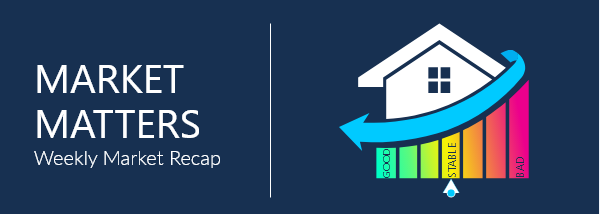Market Matters

The Fed meeting this week was the main event for the financial markets, as the Fed announced that they are raising interest rates by 50 bps and will begin their balance sheet normalization of allowing 47.5 of assets in Treasuries and MBS to runoff their balance sheet beginning June 1st. That runoff will grow to 95 billion after three months. Market seemed to like the news, with a strong rally after the meeting and Fed Chairman Powell's press conference. That rally was wiped out on Thursday as an especially brutal day for bonds and equities as all the US stock indices had steep selloffs along with yields on US Treasuries climbing higher. Best to be defensive here as we still have a hawkish Fed that is trying to rein in inflation.
 Initial Jobless Claims
Initial Jobless Claims
For the week ending April 30th, initial jobless claims rose to 200k from the prior week's revised level of 181k (orig. 180k). Continuing claims, which lag by a week, fell -19k to 1.384mln from a prior 1.403mln. This is the lowest count now for continuing claims since January 1970. The 4-week moving average on headline claims moved back up to 188k, while the 4-week moving average for continued claims is at 1.417mln.
 Productivity
Productivity
Q1 Productivity declined -7.5% annualized, while unit labor costs rose 11.6%. This was the largest productivity decline in records all the way back to the 1960s, as unit labor costs saw the highest increase since Q4 2020. Within Q1 numbers, nonfarm business output slid -2.4% annualized, the first decline since the pandemic's major impact in Q2 2020. Aggregate hours worked rose by 5.5%, which was much stronger than Q4's 2.5%, but still posting close to the 2021 average of 5.0%. Compensation per hour rose at a 3.2% rate, however, that is down significantly from 7.4% and a four-quarter low. Real hourly compensation fell by -5.5%, now the third decline in a row, and by far the largest of the three. Finally, unit non-labor costs rose by 3.5% annualized.
 Construction Spending
Construction Spending
Construction Spending for March rose .1%, to a seasonally adjusted rate of $1.730.5bln, while February's numbers were revised to $1.728.6bln. Looking year over year in March, total construction spending was up 11.7%. Within the report, private construction grew by .2%, with residential construction up 1.0% and nonresidential up 1.2%. Public construction declined by -.2% in March, with educational down -.8%, and highway down -.4%.
 ISM Manufacturing PMI
ISM Manufacturing PMI
The ISM Manufacturing PMI fell from 57.1 in March to 55.4 in April. Seventeen out of the 18 measured industries reported growth, however, with the only exception being petroleum and coal products. New orders fell -.3% on the month to 53.5, down -8.2 points in the past two months and now the lowest point since May 2020. Production also dropped by -.9%, the weakest since that same time frame. Employment declined by -5.4 points to 50.9, now at its lowest since last September, while inventories fell -3.9 points to 51.6, their lowest since last July. Supply chain issues have once again become a dominant factor in respondent comments, though one noted some improvement (in the Transportation Equipment industry). A couple respondents also highlighted the effects of COVID-related lockdowns in China.

